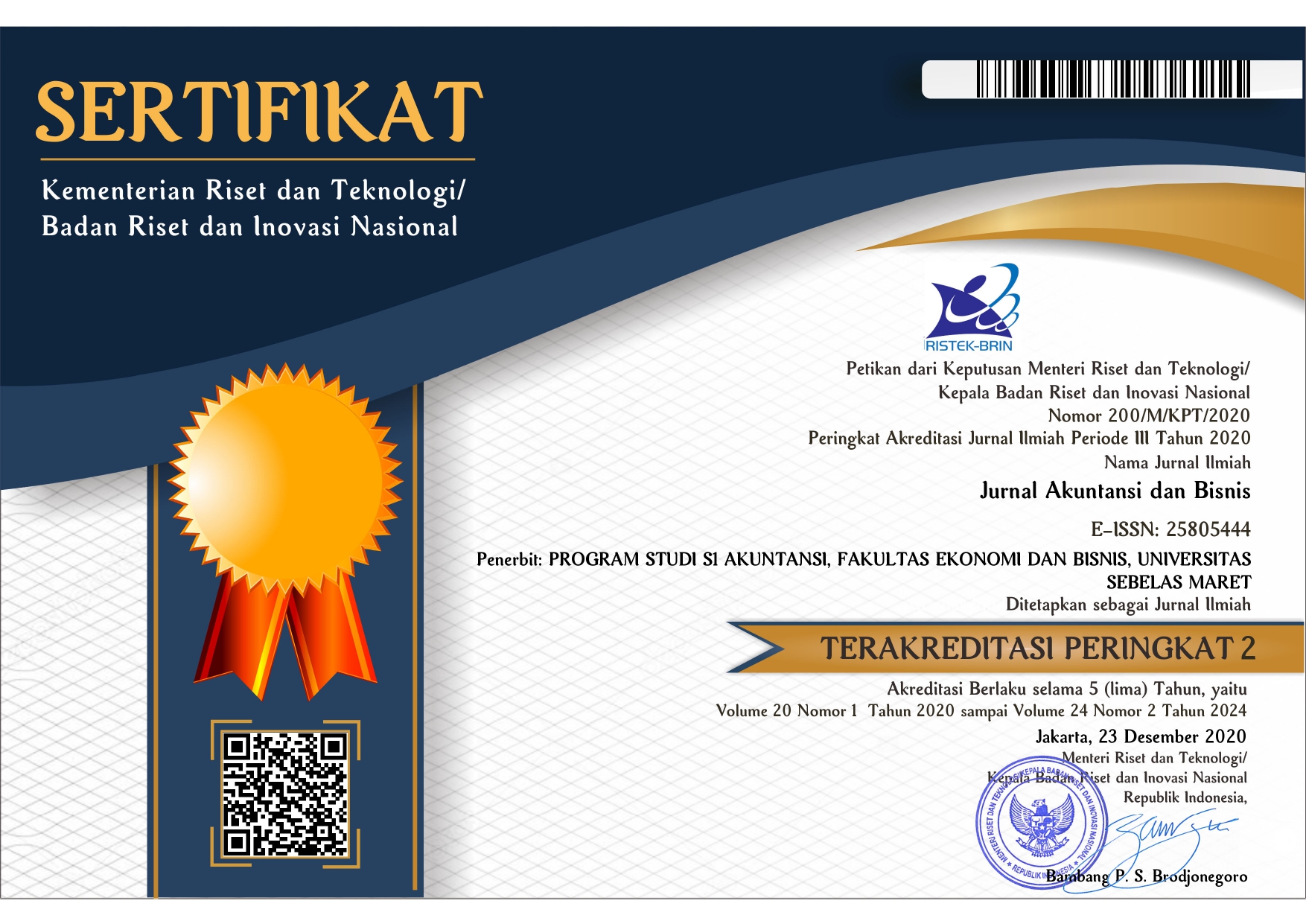Perspektif Theory of Planned Behavior Kaitannya dengan Intensi Berwirausaha: Peran Gender sebagai Moderator
Abstract
Keywords: entrepreneurship, intention, gender, theory of planned behavior.
Full Text:
PDFReferences
Ajzen, I. (1991). The theory of planned behavior. Organizational Behavior & Human Decision Processes, No 50 Vol 2, 179-211.
Ajzen, I., (2005). Theory of planned behavior: frequently asked questions. Diperoleh 10 November 2016 dari http://www.people.umass.edu.aizen.faq.html
Baughn, C. C, Bee-Leng, C & Kent E. N. (2006). The Normative Context for women’s participation in entrepreneurship: a multicountry study. Entrepreneurship Theory and Practice, 687-708.
Bisnis Indonesia (2017, 10 Maret), Diperoleh 9 September 2017s dari http://industri.bisnis.com/read/20170310/257/635611/ini-empat-kendala-utama-perempuan-pengusaha-di-indonesia
Budhwar, P., S. Saini, D.S & Bhatnagar, J. (2005). Women in Management in the New Economic Environment: The Case of India. Asia Pacific Business Review, Vol 11, 179-193.
CNBC, ( 2017, 10 Februari), Diperoleh 9 September 20017 dari https://www.cnbc.com/2017/02/28/why-women-entrepreneurs-will-be-economic-force-to-reckon-with-in-2017.html
Daymard, A. (2015). Determinants of Female Entrepreneurship in India. Economics Department Working Papers No. 1191, Diperoleh pada 9 September 2017 dari http://www.oecd.org/officialdocuments/publicdisplaydocumentpdf/?cote=ECO/WKP(2015)9&docLanguage=En
Gender Monitoring Office. (2017). Gender and Access to Finance. Diperoleh pada 9 September 2017 dari http://gmo.gov.rw/fileadmin/user_upload/Gender_and_Access_to_Finance_Booklet_GMO_March_2017.pdf pada 9 September 2017.
Kelley, D., C. Brush, O, & Greene, Y., (2013), Litovsky and Global Entrepreneurship Research Association. Global Entrepreneurship Monitor 2012 Women’s Report.
Merdeka. (2017, 15 Mei). Jumlah Pengusaha Wanita Meningkat jadi 14,3 juta orang. Diperoleh 9 September 2017 dari https://www.merdeka.com/uang/jumlah-pengusaha-wanita-meningkat-jadi-143-juta-orang.html
Minniti, M & Naude, W. (2010). What Do We Know about the Patterns and Determinants of Female Entrepreneurship across Countries? European Journal of Development Research Vol 22, 277-293.
Otoritas Jasa Keuangan. (2016). Survei Nasional Literasi dan Inklusi Keuangan. Diperoleh pada 9 September 2017 dari http://www.ojk.go.id/id/berita-dan-kegiatan/siaran-pers/Documents/Pages/Siaran-Pers-OJK-Indeks-Literasi-dan-Inklusi-Keuangan-Meningkat/17.01.23%20Tayangan%20%20Presscon%20%20nett.compressed.pdf
UNESCO. (2012) World Atlas of Gender Equality in Education. Diperoleh pada 9 September 2017 dari http://www.unesco.org/new/en/education/themes/leading-the-international-agenda/gender-and-education/resources/the-world-atlas-of-gender-equality-in-education/
Van Praag, C Mirjam & Peter H. Versloot. (2007). What is the value of entrepreneurship? A review of recent research. Small Business Economics December, Vol 29 No 4, 351-382.
World Bank. (2014). Measuring Financial Inclusion Around the World. Global Findex. Diperoleh 9 September 2017 dari http://www.worldbank.org/en/programs/globalfindex
Otoritas Jasa Keuangan. (2016). Survei Nasional Literasi dan Inklusi Keuangan. Diperoleh pada 9 September 2017 dari http://www.ojk.go.id/id/berita-dan-kegiatan/siaran-pers/Documents/Pages/Siaran-Pers-OJK-Indeks-Literasi-dan-Inklusi-Keuangan-Meningkat/17.01.23%20Tayangan%20%20Presscon%20%20nett.compressed.pdf
UNESCO. (2012) World Atlas of Gender Equality in Education. Diperoleh pada 9 September 2017 dari http://www.unesco.org/new/en/education/themes/leading-the-international-agenda/gender-and-education/resources/the-world-atlas-of-gender-equality-in-education/
Van Praag, C Mirjam & Peter H. Versloot. (2007). What is the value of entrepreneurship? A review of recent research. Small Business Economics December, Vol 29 No 4, 351-382.
World Bank. (2014). Measuring Financial Inclusion Around the World. Global Findex. Diperoleh 9 September 2017 dari http://www.worldbank.org/en/programs/globalfindex
DOI: http://dx.doi.org/10.20961/jab.v17i1.215
Jurnal Akuntansi dan Bisnis (JAB)
ISSN 1412-0852 (print), 2580-5444 (online)
Published by Accounting Study Program, Faculty of Economics and Business, Universitas Sebelas Maret, Indonesia

JAB on http://jab.fe.uns.ac.id/index.php/jab is licensed under a Creative Commons Attribution-ShareAlike 4.0 International License










